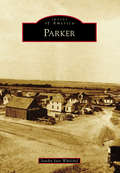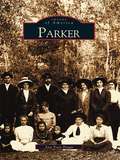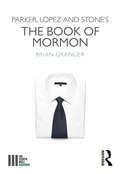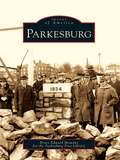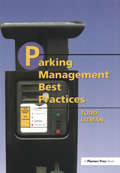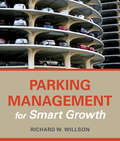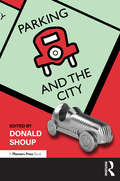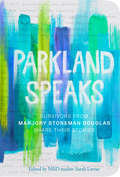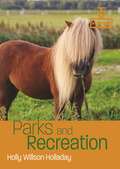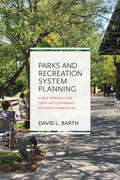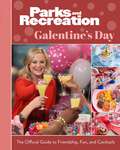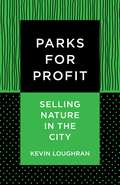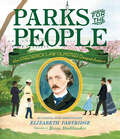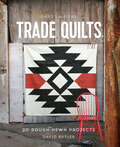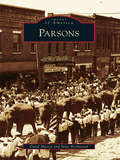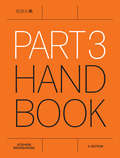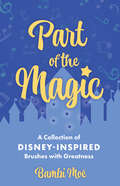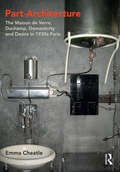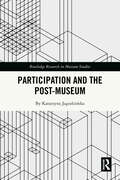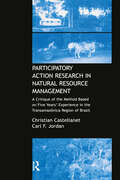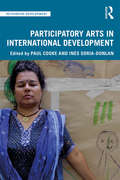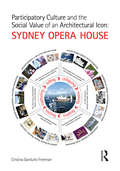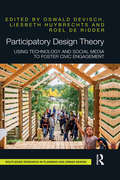- Table View
- List View
Parker
by Sandra Jane WhelchelThe town of Parker underwent several name changes before adopting its current title. First called Pine Grove for its setting in a copse of ponderosa pines at the northern edge of Colorado's Black Forest, that name lasted through the final days of stagecoach travel. When the US Post Office officially began operations in the 1880s, officials requested that Pine Grove be renamed, as another town with that name existed on the Platte River, causing the mail to be mixed up. James Sample Parker requested that the town's name be changed to Edithville, in honor of his young daughter. Again, the US Post Office denied the request, renaming the town Parker to recognize James Sample Parker and his brother, George. From these early beginnings, Parker faced spurts of growth and recession, more recently becoming a significant Denver suburb.
Parker (Images of America)
by Ann Pratt HouptParker is a community shaded by live oaks on St. Andrews Bay in the Florida Panhandle, and its history dates back to the early 1800s. This pictorial treasure celebrates the community's heritage, people, places, and events in a variety of vintage photographs that bring to life the birth and growth of this once nameless, sleepy fishing village. Highlighted in this volume are unique images of the early settlers and their descendants; fishing and boat building; the Parker School and the community's churches; the Paper Mill and Tyndall Air Force Base; and treasured pastimes and events.
Parker, Lopez and Stone's The Book of Mormon (The Fourth Wall)
by Brian Granger'Hasa Diga Eebowai' In 2011, a musical full of curse words and Mormon missionaries swept that year’s Tony Awards and was praised as a triumphant return of the American musical. This book explores the inherent achievements (and failures) of The Book of Mormon—one of the most ambitious, and problematic, musicals to achieve widespread success. The creative team members—Matt Parker, Trey Stone and composer Robert Lopez—were collectively known for their aggressive use of taboo subjects and crude, punchy humor. Using the metaphor of boxing, Granger explores the metaphorical punches the trio delivers and ruminates over the less-discussed ideological wounds that their style of shock absurdism might leave behind. This careful examination of where The Book of Mormon succeeds and fails is sure to challenge discussion of our understanding of musical comedy and our appreciation for this cultural landmark in theatre.
Parkesburg (Images of America)
by Bruce Edward Mowday Parkesburg Free LibraryParkesburg is located in Chester County, one of William Penn's original three counties. The town was first known as the Fountain Inn, after a 1730s tavern, and the tavern later became the town's first post office. Fountain Inn was renamed Parkesburg after prominent politician John G. Parke. A number of important businesses had connections to Parkesburg, including the Philadelphia and Columbia Railroad, which was later a part of the Pennsylvania Railroad. In 1872, Horace Beale moved his ironworks from nearby Hibernia to Parkesburg and named it the Parkesburg Iron Company. The company had a competitive baseball team, and major?leaguers such as Babe Ruth played against the team. The town also was home to one of the first airfields in the county.
Parking Management Best Practices
by Todd LitmanThis book is a blueprint for developing an integrated parking plan. It explains how to determine parking supply and affect parking demand, as well as how to calculate parking facility costs. It also offers information about shared parking, parking maximums, financial incentives, tax reform, pricing methods, and other management techniques. What types of locations benefit from parking management? Places with perceived parking problems. Areas with rapidly expanding population, business activity, or traffic. Commercial districts and other places with compact land-use patterns. Urban areas in need of redevelopment and infill. Places with high levels of walking or public transit or places that want to encourage those modes. Districts where parking problems hinder economic development. Areas with high land values Neighborhoods concerned with equity, including fairness to nondrivers. Places with environmental concerns. Unique landscapes or historic districts in need of preservation,"
Parking Management for Smart Growth
by Richard W. WillsonThe average parking space requires approximately 300 square feet of asphalt. That's the size of a studio apartment in New York and enough room to hold 10 bicycles. Space devoted to parking in growing urban and suburban areas is highly contested--not only from other uses from housing to parklets, but between drivers who feel entitled to easy access. Without parking management, parking is a free-for-all--a competitive sport--with arbitrary winners and losers. Historically drivers have been the overall winners in having free or low-cost parking, while an oversupply of parking has created a hostile environment for pedestrians.In the last 50 years, parking management has grown from a minor aspect of local policy and regulation to a central position in the provision of transportation access. The higher densities, tight land supplies, mixed land uses, environmental and social concerns, and alternative transportation modes of Smart Growth demand a different approach--actively managed parking.This book offers a set of tools and a method for strategic parking management so that communities can better use parking resources and avoid overbuilding parking. It explores new opportunities for making the most from every parking space in a sharing economy and taking advantage of new digital parking tools to increase user interaction and satisfaction. Examples are provided of successful approaches for parking management--from Pasadena to London.At its essence, the book provides a path forward for strategic parking management in a new era of tighter parking supplies.
Parking and the City
by Donald ShoupDonald Shoup brilliantly overcame the challenge of writing about parking without being boring in his iconoclastic 800-page book The High Cost of Free Parking. Easy to read and often entertaining, the book showed that city parking policies subsidize cars, encourage sprawl, degrade urban design, prohibit walkability, damage the economy, raise housing costs, and penalize people who cannot afford or choose not to own a car. Using careful analysis and creative thinking, Shoup recommended three parking reforms: (1) remove off-street parking requirements, (2) charge the right prices for on-street parking, and (3) spend the meter revenue to improve public services on the metered streets. Parking and the City reports on the progress that cities have made in adopting these three reforms. The successful outcomes provide convincing evidence that Shoup’s policy proposals are not theoretical and idealistic but instead are practical and realistic. The good news about our decades of bad planning for parking is that the damage we have done will be far cheaper to repair than to ignore. The 51 chapters by 46 authors in Parking and the City show how reforming our misguided and wrongheaded parking policies can do a world of good. Read more about parking benefit districts with a free download of Chapter 51 by copying the link below into your browser. https://www.routledge.com/posts/13972
Parkland Speaks: Survivors from Marjory Stoneman Douglas Share Their Stories
by Sarah LernerFeaturing art and writing from the students of the Parkland tragedy, this is a raw look at the events of February 14, and a poignant representation of grief, healing, and hope. <P><P>The students of Marjory Stoneman Douglas High School share their emotional journeys that began on February 14, 2018, and continue today. <P><P>This revealing and unfiltered look at teens living in the wake of tragedy is a poignant representation of grief, anger, determination, healing, and hope. <P><P>The intimate collection includes poetry, eyewitness accounts, letters, speeches, journal entries, drawings, and photographs from the events of February 14 and its aftermath. <P><P>Full of heartbreaking loss, a rally cry for change, and hope for a safe future, these artistic pieces will inspire readers to reflect on their own lives and the importance of valuing and protecting the ones you love.
Parks and Recreation (TV Milestones Series)
by Holly Willson HolladayAn homage to Parks and Recreation (2009–15) and an exploration of how the show evolved as a traditional network sitcom in a post-network era. This deep dive into the series highlights the new norm of digital fandom, where social media has become a means for fans to engage with the series beyond its runtime. While the media landscape evolved, so did American sociopolitical discourse; Holladay examines the series contained entirely within Barack Obama’s presidency as it reflects the role of politics in American life on a micro scale. The series follows the career and personal life of Leslie Knope (Amy Poehler), a self-possessed, midlevel bureaucrat whose initial ideology reflects the optimistic tone of politics ushered in with Obama’s campaign and early presidency. Throughout its run, Parks and Recreation engaged with political debates simmering in American culture, offering a humorous ripped-from-the-headlines take on issues such as same-sex marriage, distrust of politicians, government shutdowns, and corporate bailouts Through compelling analysis, Holladay untangles representations of women and BIPOC in the series as they engage with contemporary discourse surrounding media and identity politics.
Parks and Recreation System Planning: A New Approach for Creating Sustainable, Resilient Communities
by David BarthParks and recreation systems have evolved in remarkable ways over the past two decades. No longer just playgrounds and ballfields, parks and open spaces have become recognized as essential green infrastructure with the potential to contribute to community resiliency and sustainability. To capitalize on this potential, the parks and recreation system planning process must evolve as well. In Parks and Recreation System Planning, David Barth provides a new, step-by-step approach to creating parks systems that generate greater economic, social, and environmental benefits.Barth first advocates that parks and recreation systems should no longer be regarded as isolated facilities, but as elements of an integrated public realm. Each space should be designed to generate multiple community benefits. Next, he presents a new approach for parks and recreation planning that is integrated into community-wide issues. Chapters outline each step—evaluating existing systems, implementing a carefully crafted plan, and more—necessary for creating a successful, adaptable system. Throughout the book, he describes initiatives that are creating more resilient, sustainable, and engaging parks and recreation facilities, drawing from his experience consulting in more than 100 communities across the U.S.Parks and Recreation System Planning meets the critical need to provide an up-to-date, comprehensive approach for planning parks and recreation systems across the country. This is essential reading for every parks and recreation professional, design professional, and public official who wants their community to thrive.
Parks and Recreation: The Official Guide to Friendship, Fun, and Cocktails
by Insight EditionsGather your best girlfriends and celebrate Galentine&’s Day with this delightful entertaining guide inspired by Parks and Recreation!Join America&’s most upbeat public servant, Leslie Knope, in the year&’s best tradition—ladies celebrating ladies! Made popular by Parks and Recreation, before growing into an international phenomenon, this special day for embracing female friendship is the perfect excuse to pull out all the stops, just like Leslie. Complete with food and drink recipes, DIY decorations, ideas for party activities, and more, this official guide will help you throw an inspired Galentine&’s Day party for the women in your life. Fun and comprehensive, this is a must-have event-planning guide for every Parks and Recreation fan. • PLAN THE PERFECT GALENTINE&’S DAY: With a fun range of DIY decorations, ideas for party activities, and more, Parks and Recreation: The Official Galentine&’s Day Guide to Friendship, Fun, and Cocktails gives you everything you need to plan an exciting Galentine&’s Day event. • FABULOUS COCKTAIL AND FOOD RECIPES: Try all the delicious food and drink recipes with your favorite gal pals and celebrate Galentine&’s Day the Parks and Rec way • GREAT FOR EVERY PARKS AND REC FAN: Enjoy cocktails and activities inspired by the women of Pawnee, including Leslie Knope, Ann Perkins, Donna Meagle, April Ludgate, and more! • COMPLETE YOUR PARKS AND REC COLLECTION: This book joins Insight Editions&’ line of fan-favorite Parks and Rec titles, including Parks and Recreation: The Official Advent Calendar andParks and Recreation: Treat Yo&’ Self Journal.
Parks for Profit: Selling Nature in the City
by Kevin LoughranA new kind of city park has emerged in the early twenty-first century. Postindustrial parks transform the derelict remnants of an urban past into distinctive public spaces that meld repurposed infrastructure, wild-looking green space, and landscape architecture. For their proponents, they present an opportunity to turn disused areas into neighborhood anchors, with a host of environmental and community benefits. Yet there are clear economic motives as well—successful parks have helped generate billions of dollars of city tax revenues and real estate development.Kevin Loughran explores the High Line in New York, the Bloomingdale Trail/606 in Chicago, and Buffalo Bayou Park in Houston to offer a critical perspective on the rise of the postindustrial park. He reveals how elites deploy the popularity and seemingly benign nature of parks to achieve their cultural, political, and economic goals. As urban economies have become restructured around finance, real estate, tourism, and cultural consumption, parks serve as civic shields for elite-oriented investment. Tracing changing ideas about cities and nature and underscoring the centrality of race and class, Loughran argues that postindustrial parks aestheticize past disinvestment while serving as green engines of gentrification.A wide-ranging investigation of the political, cultural, and economic forces shaping park development, Parks for Profit reveals the social inequalities at the heart of today’s new urban landscape.
Parks for the People: How Frederick Law Olmsted Designed America
by Elizabeth PartridgeNational Book Award finalist Elizabeth Partridge reveals the life and work of Frederick Law Olmsted, the designer of Central Park, the United States Capitol building's landscape, and more.Nobody could get Frederick Law Olmsted to sit still. He was filled with energy, adventure, and dreams of changing the world. As a boy, he found refuge in the peace and calm of nature, and later as an adult, he dreamed of designing and creating access to parks for a growing and changing America. When New York City held a contest for the best park design for what would become Central Park, Olmsted won and became the father of landscape architecture. He went on to design parks across America, including Yosemite National Park and even the grounds for the United States Capitol.This scenic biography is lavishly illustrated by Becca Stadtlander, and National Book Award finalist Elizabeth Partridge brings her renowned lyricism and meticulous research to the visionary who brought parks to the people.
Parson Gray Trade Quilts: 20 Rough-Hewn Projects
by David ButlerQuilting gets a rustic modern treatment in this 20-project sewing book that celebrates American trade quilts, with touches of Native and early American influences. The timeless style of these DIY designs will inspire quilters of every skill level to make cozy style statements for their home or office. Clear, step-by-step instructions detail how to use inventive techniques such as coffee staining and bleaching to achieve a perfectly distressed vintage feel, while dozens of helpful diagrams and photographs make these projects even more accessible. From a stunning Navajo blanket to a World's Fair design comprising international antique flags, this compilation is ideal for anyone looking to create gorgeous quilts and blankets in the spirit of a bygone era.
Parsons
by Mike Brotherton David MattoxParsons, located in southeast Kansas, owes its existence to the railroad. When the first Missouri-Kansas-Texas Railroad locomotive reached the southern border of Kansas in June 1870, the railroad won two prizes, the coveted right to build across Oklahoma Indian Territory and the right to acquire extensive land grants in the territory. The fall of the same year, railroad executives selected a site for a major junction and terminal. The Parsons Town Company sold its first lots in 1871 at Parsons Junction, named for railroad president Judge Levi Parsons. Because of the town's phenomenal growth, it soon earned the title of "Infant Wonder of the West." The photographs contained in this book, including some of the earliest known of Parsons, serve as testimony to the energies and ingenuity of early settlers. These images also depict the development of Parsons-on-the-Prairie and its transformation from frontier town to the "Queen City of the Great Southwest."
Part 3 Handbook
by Stephen BrookhouseThe decision to take the final step to becoming a fully qualified architect exam can be daunting. Fortunately, this new edition of the Part 3 Handbook demystifies the whole process of qualifying, dispelling commonly held myths and offering genuine insight into what examiners really want. Written by an experienced practitioner and Professional Studies Advisor, and endorsed by the RIBA, the book concentrates on the separate elements that you will be assessed on in the Part 3 exam. Fully updated for 2020, this edition features a brand new chapter on professional development and includes up-to-date guidance on the 2020 plan of work.
Part I - Early English Stages 1576-1600
by Glynne WickhamThis volume forms part of the 5 volume set Early English Stages 1300-1660. This set examines the history of the development of dramatic spectacle and stage convention in England from the beginning of the fourteenth century to 1660.
Part II - Early English Stages 1576-1600
by Glynne WickhamThis volume forms part of the 5 volume set Early English Stages 1300-1660. This set examines the history of the development of dramatic spectacle and stage convention in England from the beginning of the fourteenth century to 1660.
Part of the Magic: A Collection of Disney-Inspired Brushes with Greatness
by Bambi MoéPart of the Magic: A Collection of Disney-Inspired Brushes with Greatness is a book of remarkable and wildly entertaining anecdotal stories told through the lens of an entertainment industry insider. Author Bambi Moé enjoyed a twenty-year career at The Walt Disney Company in charge of all aspects of music for Walt Disney Television Animation. Her name, vocation, and background gave her exceptional access to pop culture and entertainment giants. The book takes readers on a nonstop ride and keeps them riveted throughout extremely candid encounters shared here for the first time. Moé’s fascinating true stories provide a rare insight into the creative process associated with music in animation and give readers a historical reference to The Walt Disney Company’s burgeoning direct-to-video empire. Her career exemplifies the rewards often associated with hard work, perseverance, integrity, and the ability to recognize potential in others. Often the only woman in a male-dominated work environment, Moé’s success will inspire young readers interested in pursuing a career in entertainment. Part of the Magic invites readers to consider their own stories and recognize their own universality. Like a photo that captures life’s moments and teaches us lessons, each of Moé’s brushes with greatness serves as a reminder that we are all connected by reason of our own humanity. Her joy extends far beyond the original encounter and multiplies in the retelling of these stories.
Part-Architecture: The Maison de Verre, Duchamp, Domesticity and Desire in 1930s Paris
by Emma CheatlePart-Architecture presents a detailed and original study of Pierre Chareau’s Maison de Verre through another seminal modernist artwork, Marcel Duchamp’s Large Glass. Aligning the two works materially, historically and conceptually, the book challenges the accepted architectural descriptions of the Maison de Verre, makes original spatial and social accounts of its inhabitation in 1930s Paris, and presents new architectural readings of the Large Glass. Through a rich analysis, which incorporates creative projects into history and theory research, the book establishes new ways of writing about architecture. Designed for politically progressive gynaecologist Dr Jean Dalsace and his avant-garde wife, Annie Dalsace, the Maison de Verre combines a family home with a gynaecology clinic into a ‘free-plan’ layout. Screened only by glass walls, the presence of the clinic in the home suggests an untold dialogue on 1930s sexuality. The text explores the Maison de Verre through another radical glass construction, the Large Glass, where Duchamp’s complex depiction of unconsummated sexual relations across the glass planes reveals his resistance to the marital conventions of 1920s Paris. This and other analyses of the Large Glass are used as a framework to examine the Maison de Verre as a register of the changing history of women’s domestic and maternal choices, reclaiming the building as a piece of female social architectural history. The process used to uncover and write the accounts in the book is termed ‘part-architecture’. Derived from psychoanalytic theory, part-architecture fuses analytical, descriptive and creative processes, to produce a unique social and architectural critique. Identifying three essential materials to the Large Glass, the book has three main chapters: ‘Glass’, ‘Dust’ and ‘Air’. Combining theory text, creative writing and drawing, each traces the history and meaning of the material and its contribution to the spaces and sexuality of the Large Glass and the Maison de Verre. As a whole, the book contributes important and unique spatial readings to existing scholarship and expands definitions of architectural design and history.
Participation and the Post-Museum (Routledge Research in Museum Studies)
by Katarzyna JagodzińskaParticipation and the Post-Museum discusses the concept of participation in museum practice, as well as ideas that constitute the paradigm of the post-museum.Based on extensive empirical research conducted in thirty diverse Polish museums and drawing upon her own museum practice, the author considers whether museums are democratising, or whether this is an illusion that obscures the reinforcement of the authoritarian position that is historically inherent to museums. Referring to different areas of museum practice, the author analyses not only ‘how’ and ‘why,’ but mostly ‘if’ museums are capable and willing to share their power with the public – and how it affects their identity. Drawing on literature from the fields of political and social sciences, as well as cultural and museum studies, on participation and applicability of the term in museums, it becomes apparent that using participatory tools, even when they empower the public to co-author, collaborate, and take co-responsibility, does not necessarily lead to participatory museums.Participation and the Post-Museum argues that museums rooted in the modernist tradition are usually not ready to share power and responsibility with non-experts from outside the museum world. It will be of interest to academics and students of museum studies, museum professionals, culture management, and heritage studies around the world.
Participatory Action Research in Natural Resource Management: A Critque of the Method Based on Five Years' Experience in the Transamozonica Region of Brazil
by Carl F. Jordan Christian CastellanetThis work evaluates the merits of a widely-used approach to natural resource management, participatory action research (PAR), an approach to resource management that strives to link researchers with farmers and other local residents whose lives are effected by long-range conservation programmes. The authors begin the book with the history of PAR, and then use a variety of case studies that chronicle sustainable development efforts in Brazil. They evaluate the strengths and weaknesses of these efforts and suggest specific ways to improve on future PAR efforts.
Participatory Arts in International Development (Rethinking Development)
by Paul Cooke Inés Soria-DonlanThis book explores the practical delivery of participatory arts projects in international development. Bringing together an interdisciplinary group of academics, international development professionals and arts practitioners, the book engages honestly with the competing challenges faced by the different groups of people involved. Participatory arts are becoming increasingly popular in international development circles, fuelled in part by the increased accessibility of audio-visual media in the digital age, and also by the move towards participatory discourses in the wake of the UN’s Agenda 2030. The book asks: What do participatory arts projects look like in practice, and why are they used as an international development tool? How can we develop practical and sustainable development projects on the ground, localising best practice according to cultural, economic and linguistic contexts? What are the enablers of, and barriers to, successful participatory initiatives, and how can we evaluate past projects to learn and feed into future projects? Written to appeal to both academics and practitioners, this book would also be suitable for teaching on courses related to participatory development, community arts, and culture and development.
Participatory Culture and the Social Value of an Architectural Icon: Sydney Opera House
by Cristina Garduno FreemanThis book develops new and innovative methods for understanding the cultural significance of places such as the World Heritage listed Sydney Opera House. By connecting participatory media, visual culture and social value, Cristina Garduño Freeman contributes to a fast-growing body of scholarship on digital heritage and the popular reception of architecture. In this, her first book, she opens up a fresh perspective on heritage, as well as the ways in which people relate to architecture via participation on social media. Social media sites such as YouTube, Pinterest, Wikipedia, Facebook and Flickr, as well as others, become places for people to express their connections with places, for example, the Sydney Opera House. Garduño Freeman analyses real-world examples, from souvenirs to opera-house-shaped cakes, and untangles the tangible and intangible ways in which the significance of heritage is created, disseminated and maintained. As people’s encounters with World Heritage become increasingly mediated by the digital sphere there is a growing imperative for academics, professionals and policy-makers to understand the social value of significant places. This book is beneficial to academics, students and professionals of architecture.
Participatory Design Theory: Using Technology and Social Media to Foster Civic Engagement
by Oswald Devisch Liesbeth Huybrechts Roel De RidderIn recent years, many countries all over Europe have witnessed a demand for a more direct form of democracy, ranging from improved clarity of information to being directly involved in decision-making procedures. Increasingly, governments are putting citizen participation at the centre of their policy objectives, striving for more transparency, to engage and empower local individuals and communities to collaborate on public projects and to encourage self-organization. This book explores the role of participatory design in keeping these participatory processes public. It addresses four specific lines of enquiry: how can the use and/or development of technologies and social media help to diversify, to coproduce, to interrupt and to document democratic design experiments? Aimed at researchers and academics in the fields of urban planning and participatory design, this book includes contributions from a range of experts across Europe including the UK, Belgium, the Netherlands, Italy, Denmark, Austria, Spain, France, Romania, Hungary and Finland.
